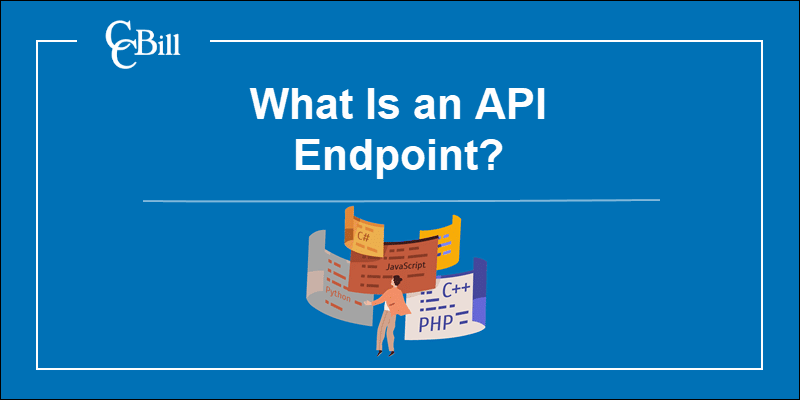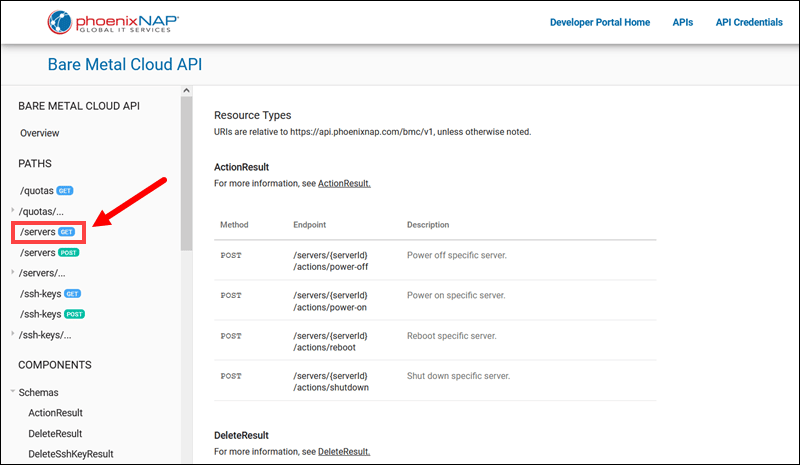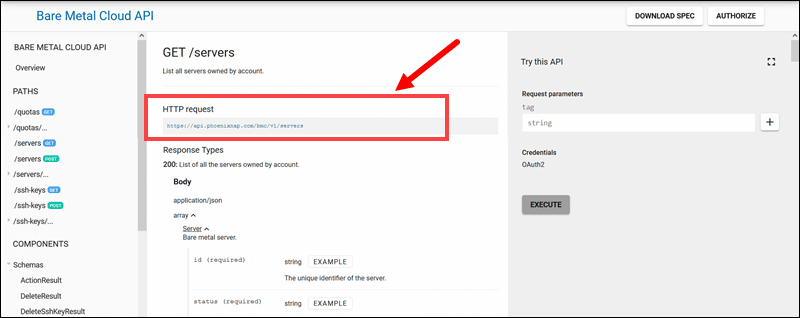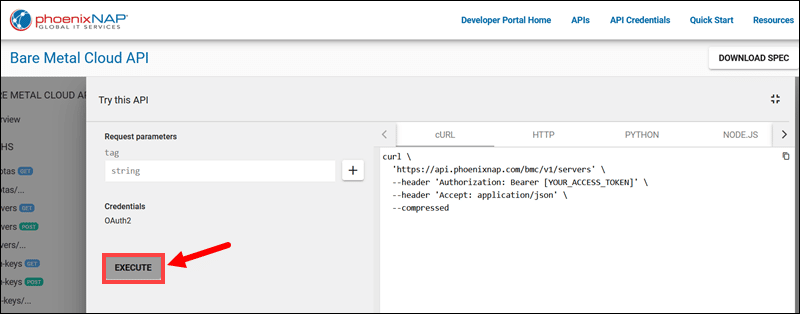Introduction
Companies are struggling to adjust their business processes, introduce new technical solutions, and meet customer expectations in a fast-paced digital environment.
APIs allow businesses to build up their core capabilities, integrate with popular platforms, and farm out non-core activities to third-party providers.
Developers cannot proceed with an API integration until they understand the API’s capabilities, find out how to structure an API call, and identify the endpoints for accessing API resources.
Learn about API endpoints and why they are essential to any API integration.

API Endpoint Definition
An API endpoint is a network location that enables a client application to access an API resource.
By sending a request to the specified location, the client prompts the server resource to perform an action. An API resource typically serves multiple clients through the endpoint.
API owners provide documentation that lists API endpoints, describes what type of resources they give access to, and specifies the request methods and parameters.
API Vs. Endpoint: What's The Difference?
An Application Programming Interface (API) enables two applications to interact over a network, regardless of their programming language or architectural design. An API enforces rules and constraints that a client application must adhere to when communicating with a resource.
API endpoints are the touchpoints for this communication. The endpoint URI (Uniform Resource Identifier) represents the resource location to which API users must send their requests.
One API solution can have hundreds of endpoints that perform numerous actions and provide access to different resources.
How to Use API Endpoints?
The endpoint URI (Uniform Resource Identifier) format can vary depending on the API type and architectural style. API endpoints for web-based applications usually take the form of a URL.
Developers use web browsers or send curl requests from a terminal to interact with an API endpoint.
The RESTful API architectural style is one of the most popular protocols for creating web-based apps and services.
A typical RESTful API request has 5 elements:
- Verb − Identifies the HTTP request function (i.e., GET, POST, DELETE, PUT, PATCH).
- Endpoint URI (Uniform Resource Identifier) − The location of the resource on the server.
- HTTP Version − Indicates the HTTP version.
- Request Headers − An HTTP header contains metadata about the resource or the client initiating the call. This includes authorization data, formats supported by the client, authentication methods, etc.
- Request Body − The request body contains API parameters the client sends in the specified data format.
For example, CCBill’s RESTful Transaction API uses bearer tokens to authorize client requests. To receive a bearer token (for accessing CCBill’s API resources), the client needs to send an API call to the https://api.ccbill.com/ccbill-auth/oauth/token endpoint.
As seen in this example, the API endpoint is a mandatory element of the request:
curl - POST 'https://api.ccbill.com/ccbill-auth/oauth/token' \
--header 'Content-Type: application/x-www-form-urlencoded' \
--header 'Authorization: Basic Merchant_ApplicationID:Merchant_Secret ' \
--data-urlencode 'grant_type=client_credentials'API owners often provide Software Development Kits (SDK) to streamline the API integration process. SDKs give developers access to specific tools, documentation, software libraries, and code examples they need to automate API call iterations and complete the integration with minimal friction.
API Endpoint Examples
The CCBill RESTful Transaction API allows merchants to integrate their applications with CCBill’s payment platform. Merchants can use CCBill’s API to tokenize customer payment information, charge customers using payment tokens, or retrieve data about existing transactions. The API’s base URL is:
https://api.ccbill.com/Endpoint URIs are appended to the base URL to provide access to different API resources. For example, the /payment-tokens/merchant-only endpoint is used to create payment tokens. Merchants need to send an API request to the following URL endpoint:
https://api.ccbill.com/payment-tokens/merchant-onlyThe API call must contain the required parameters listed in CCBill’s API documentation. The following API call, written in PHP, contains the endpoint URI, HTTP method, header, and request parameters:
<?php
$request = new HttpRequest();
$request->setUrl('https://api.ccbill.com/payment-tokens/merchant-only');
$request->setMethod(HTTP_METH_POST);
$request->setHeaders(array(
'Cache-Control' => 'no-cache',
'Authorization' => 'Bearer eyJhbGciOiJSUzI1NiIsInR5cCI6IkpXVCJ9mIfkrfQ',
'Content-Type' => 'application/json'
));
$request->setBody('{ "clientAccnum": 900000, "clientSubacc": 0, "customerInfo": { "customerFname": "Tyler", "customerLname": "Thomas", "address1": "Woodland Drive", "address2": "Apt 21", "city": "Tempe", "state": "AZ", "zipcode": "85281", "country": "US", "phoneNumber": "5555555555", "email": "tthomas@xyz.com", "ipAddress": "10.70.60.14", "browserHttpUserAgent": "Mozilla/5.0 (Windows NT 6.1; Win64; x64; rv:60.0) Gecko/20100101 Firefox/60.0", "browserHttpAccept": "text/html,application/xhtml+xml,application/xml;q=0.9,*/*;q=0.8", "browserHttpAcceptLanguage": "en-US,en;q=0.5", "browserHttpAcceptEncoding": "gzip, deflate, br" }, "paymentInfo": { "creditCardPaymentInfo": { "cardNum": "4473707989493598", "nameOnCard": "Tyler Thomas", "expMonth": "04", "expYear": "2019" } }, "subscriptionId":900000000000000001, "timeToLive": 30, "validNumberOfUse": 3 }');
try {
$response = $request->send();
echo $response->getBody();
} catch (HttpException $ex) {
echo $ex;
}
?>Merchants can then use the payment token to charge a customer by sending a new request to the /transactions/payment-tokens/{payment_token_id} endpoint:
https://api.ccbill.com/transactions/payment-tokens/{payment_token_id}The payment_token_id value is included in the endpoint URI:
<?php
$request = new HttpRequest();
$request->setUrl('https://api.ccbill.com/transactions/payment-tokens/01047ed6f3b440c7a2ccc6abc1ad0a84');
$request->setMethod(HTTP_METH_POST);
$request->setHeaders(array(
'Cache-Control' => 'no-cache',
'Authorization' => 'Bearer eyJhbGciOiJSUzI1NiIsInR5cCI6IkpXVCJ9.e',
'Content-Type' => 'application/json'
));
$request->setBody('{ "clientAccnum":900123, "clientSubacc":10, "initialPrice": 9.99, "initialPeriod": 10, "recurringPrice": 15.00, "recurringPeriod": 30, "rebills": 99, "currencyCode": 840, "lifeTimeSubscription": false, "createNewPaymentToken": false, "passThroughInfo": [ { "name": "val1", "value": "val2" } ] }');
try {
$response = $request->send();
echo $response->getBody();
} catch (HttpException $ex) {
echo $ex;
}
?>Merchants can retrieve transaction data by initiating an API call to the following endpoint:
https://api.ccbill.com/payment-tokens/{payment_token_id}The GET method used for this request only retrieves data without changing the state of the resource:
<?php
$request = new HttpRequest();
$request->setUrl('https://api.ccbill.com/payment-tokens/01047ed6f3b440c7a2ccc6abc1ad0a84');
$request->setMethod(HTTP_METH_GET);
$request->setHeaders(array(
'Cache-Control' => 'no-cache',
'Authorization' => 'Bearer y25GKPZgIHViMrJmwSKqG2kC60JEYDrOsZsajhicbKPytXw'
));
try {
$response = $request->send();
echo $response->getBody();
} catch (HttpException $ex) {
echo $ex;
}
?>The API resource responds by sending a set of parameters a merchant can capture and use to initiate new requests or power other processes or applications.
Why Are API Endpoints Important?
Despite the name, an endpoint is one of the first elements a developer looks for when starting to work on an API integration. Some of the benefits of APIs and API endpoints include:
- Lower Development Costs - Software development is time-consuming and requires specialized staff. Using APIs and integrating ready-made solutions is more efficient and cost-effective than developing proprietary applications from scratch. API endpoints expose countless resources and sub-resources that would otherwise remain unavailable.
- Digital Transformation - APIs are invaluable for businesses undergoing a digital transformation. Endpoints can simplify and enhance the visibility of app interactions and identify individual resources within a system.
- Customer Reach - It is challenging to reach customers in a market saturated by tech giants and ad companies. APIs are ideal for distributing products and services to new customers and personalizing individual customer sessions.
- Automation - API endpoints are easy to understand and suitable for automating workloads, thanks to widgets and code libraries.

- Device Agnostic - Customers expect the same level of service and usability regardless of the device or platform they use. Decoupling front-end and back-end applications is the most efficient way to deliver a seamless user experience. Developers can utilize API endpoints as a shortcut when developing the same app for different systems, devices, and platforms.
- Partnerships - An API endpoint is a gateway for tapping into third-party services. However, it also allows your partners to consume your solutions. Companies can monetize their APIs by exposing them to other companies.
- Omnichannel Business Model - API endpoints enable developers and other team members to embed content throughout apps and websites. The information is automatically delivered to any location the customer feels is useful and desirable. Thanks to API endpoints, incorporating digital resources into physical locations and devices has never been easier.
How to Test API Endpoints?
During the integration process, developers often need to iterate API calls. To test API endpoints, clients must:
- Register with the API provider and receive an API key.
- Structure API calls using the instructions from the API provider’s documentation. This includes creating headers, using the correct methods, and adding all the necessary parameters.
- Send a structured API request to the correct endpoint.
- Receive the API server response and verify and process the delivered data.
Several API platforms help developers write scripts and test their applications; these include Postman, Insomnia, Testfully, etc.
Some companies provide interactive API documentation that allows developers to test requests during the API integration process. A good example is phoenixNAP, a data center company, and IaaS provider.
The Bare Metal Cloud API is designed for managing server infrastructure using API calls. After registering with the phoenixNAP BMC service, developers can select the API resource endpoint they want to test. The page provides methods and descriptions for each endpoint.

Selecting a resource URI gives developers access to parameters, endpoints, and responses for that specific resource.

The Try this API section lets developers enter the necessary data directly on the API page. The Execute button triggers an API call to the specified endpoint and displays the endpoint’s answer.

When testing API endpoints, developers must analyze responses for individual API requests:
- HTTP status code - Check if you received the expected HTTP status code.If the code did not result in a successful request, refer to the API documentation when analyzing the response code message.
- Response parameters - Verify that the parameters, field names, and values reflect the values outlined in the API documentation. Perform this action for error responses as well.
- Response headers - The HTTP response header contains metadata that can severely affect security and performance. Check the response header data.
- Analyze API call and response performance - The test is considered to have failed if an operation takes longer than expected, even if it was successful.
A failure or inconsistency in API requests or responses requires developers to repeat the API calls until they receive the desired result.
How to Secure API Endpoints?
Businesses use APIs to streamline internal processes and expose their products and services to other companies and end-users.
In these instances, API endpoints need to be secured as they facilitate external access to a company’s most valuable resources.
To secure API endpoints:
- Implement TLS - Implement a TLS certificate to secure and encrypt communication between browsers and a resource server. TLS/SSL certificates are instrumental in preventing man-in-the-middle attacks.
- Use Basic Auth for non-critical resources - Use API keys to allow registered clients to access non-critical resources programmatically. Not all resources require two-factor authentication.
- Limit interactions - Set limits on the number of interactions a single client can initiate in a short period. Limiting interactions is essential for preventing DDoS attacks.
- Use OAuth2 to authorize clients - Providers usually assign clients a Client ID and Client Secret upon registering for an API service. To protect critical resources, API providers should also require clients to obtain a bearer token to authorize their API requests.
- Validate Input - Prevent attacks like SQL injection by enforcing data types and formats for all API requests. Requests must adhere to specific guidelines, including data formats, naming conventions, and link formats.
- Filter requests by IP - API providers with a limited number of clients should only allow API calls originating from registered IPs. Companies can also block requests coming from countries or regions they consider to be high risk or in which they have no business interests.
How to Monitor API Endpoints?
Companies that expose API resources need to monitor endpoints to improve their API’s reliability, security, and performance. Some of the best practices for monitoring API endpoints include:
- Around-the-clock monitoring - An API typically has multiple dependencies and is powered by distributed systems spanning multiple servers. Automated endpoint monitoring and testing are vital for identifying and troubleshooting potential issues.
- Validate Functional Uptime - Analyze uptime and functionality for individual endpoints, but also micromanage endpoints and validate request efficiency for each method (i.e., CREATE, READ, UPDATE).
- Monitor API Dependencies - Businesses that provide API resources frequently also consume third-party APIs. A company must monitor its API endpoints but also needs to track and analyze responses originating from third-party solutions.

- Efficient Alerting System - Without a capable and automated alerting system, staff needs continuously supervise and check for potential issues. Manual supervision may negatively impact the system’s availability.
- External Monitoring - An external tool or service that monitors API endpoints from the client’s perspective may detect API errors more efficiently than an internal tool.
- Inspect Response Parameters - Status codes are a useful element for processing responses. However, they are often generic and do not provide enough information to determine endpoint performance. Track responses for specific error codes and analyze response parameters and headers to determine if there are any endpoint issues.
Using Monitoring Tools
When choosing an API endpoint monitoring tool, look for:
- Data Visualization - Extensive data sets, sheets, and tables deliver valuable information about the performance of an API endpoint. However, in emergencies, it is better to have a tool that conveys data visually and enables technicians to identify problems easily.
- Data Validation - A tool that only monitors the response speed and availability of a resource may result in an incomplete analysis. Validating data accuracy is imperative for ensuring that the API client receives responses with little or no friction.
- A monitoring tool you like - A tool that offers advanced and complex features is valuable only if those features are utilized to their fullest. Choosing a user-friendly and practical tool with fewer functionalities you enjoy using helps you understand and respond to endpoint monitoring data more efficiently.
- Custom Monitoring Intervals - Setting up custom intervals for API endpoint monitoring and the ability to run ad hoc monitors is an essential feature for any monitoring tool.
- Flexibility - Tool technology stacks often include a multitude of software solutions. It can be challenging to incorporate a new tool into an existing technology stack if it is not adaptable or flexible.
- Continuous Integration and Development Pipeline - A tool that can be integrated into the CI/CD pipeline is invaluable for analyzing and improving DevOps processes.
Conclusion
You know how API endpoints work and the best practices for testing, securing, and monitoring API endpoints.
API endpoints are a gateway for tapping into services that add functionality to your apps and elevate the customer’s experience.
Use API endpoints and coordinate your efforts with API providers to unlock the full potential of an API solution.
